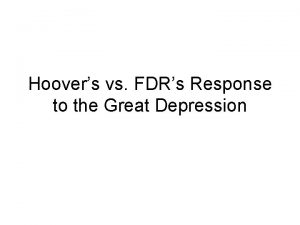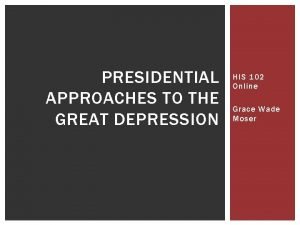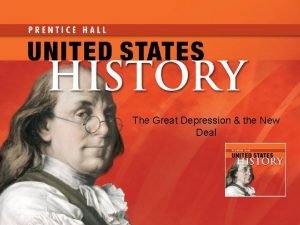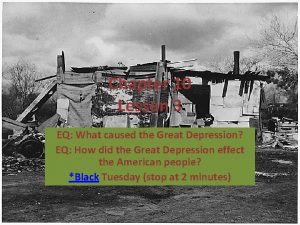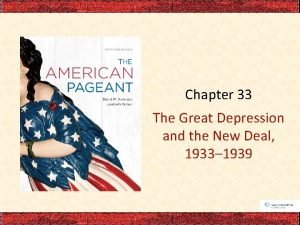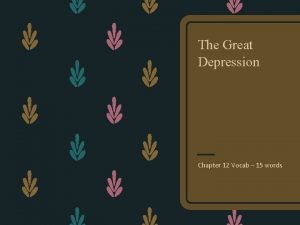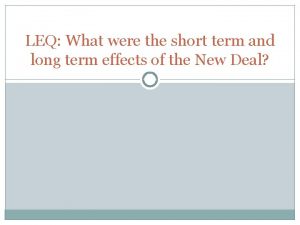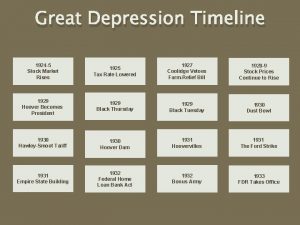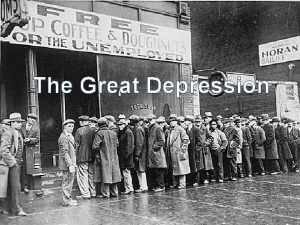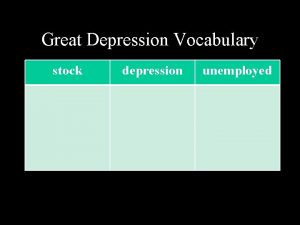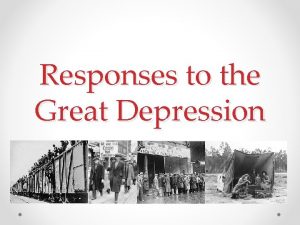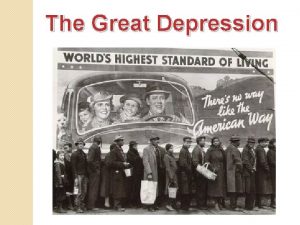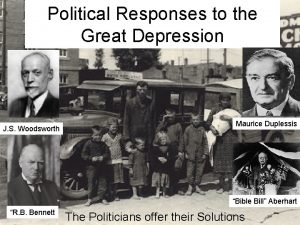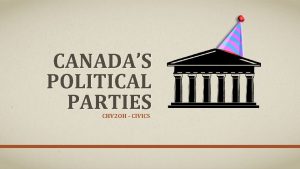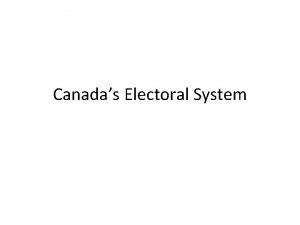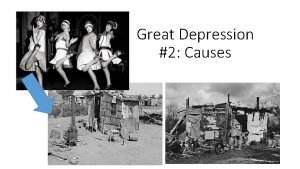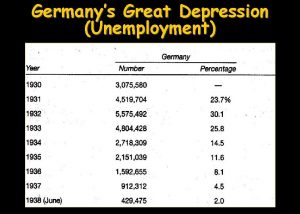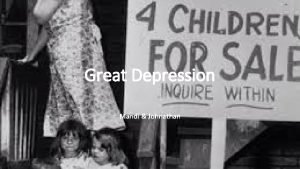Political Responses to the Great Depression Canadas Great























- Slides: 23

Political Responses to the Great Depression Canada’s Great Depression IB History of the Americas Mac. Kenzie King J. S. Woodsworth Maurice Duplessis “R. B. Bennett “Bible Bill” Aberhart The Politicians offer their Solutions

Guiding Questions Compare and contrast the government’s response to the Depression in Canada and the US. To what extent did the policies of Bennett and King bring an end to the Great Depression in Canada How did the Great Depression change the relationship between government and business in Canada?

How did the Government Respond? At this point in Canadian History, the social programs that we know of today such as Employment Insurance and Welfare did not exist. How will those Canadians most seriously affected by the Great Depression make ends meet? What would the government of Prime Minister Mac. Kenzie King do? 27% Unemployment Mac. Kenzie King

W. L. Mac. Kenzie King Prime Minister (Liberal Party) of Canada from 1921 to 1930. First term struggle to work with the Progressive Party and his own Liberal Party, especially on the issue of tariffs (which prairie progressives wanted lowered). Mac. Kenzie King’s government presided over a period of unrest among farmers in the Prairies as farm prices declined. He also faced growing dissent from WWI veterans who expected their sacrifices to be compensated during difficult economic times.

Black Tuesday Canada’s stock market (Toronto) was closely linked to the NYSE, thus when the U. S. market crashed so did the CSE 1929 -1933: GNP fell 40% (37% US), unemployment rose to 27%, exports in wheat, minerals and timber fell by 50%. Under Mac. Kenzie King’s laissez-faire leadership the national government took minimal action to provide relief or encourage economic recovery. Relief programs were the responsibility of ill-equipped provincial governments.

Homeless Canadian family in Western Canada during the heart of the Depression

King’s Response to the Depression Mac. Kenzie King thought that it was the responsibility of the provinces to aid their own citizens. He wasn’t prepared for the depression (not many political leaders were) and so he didn’t take an interventionist approach to the Economy. King was eventually openly criticized for his controversial comment that he wouldn’t give “a five cent piece” of relief money to any province that had a Conservative Government He won’t give “a five cent piece”

Enter “Bonfire” Bennett R. B. Bennett was Leader of the Conservative Party of Canada He had the nickname “bonfire” because of his bombastic (loud) speaking style. On July 28 th, 1930 R. B. Bennett became Prime Minister of Canada. Originally from New Brunswick, grew up to be a self-made millionaire as a corporate lawyer and businessman in Calgary. Given his “rags to riches” humble beginnings, he believed in capitalism and the free-enterprise system (i. e. leave economy alone and everything will work out in the end) Prime Minister R. B. Bennett

Bennett tried to combat the depression by increasing trade within the British Empire and imposing tariffs for imports from outside the Empire. Known as the Imperial Preference Policy Conservative pro-business policies provided little relief for the unemployed

Bennett’s Response to the Depression He put $ 20 Million dollars towards emergency relief He raised the tariffs on imports to 50% in order to protect Canada’s industries from foreign competition and end the trade deficit. (Do you think this would work? ) “Bonfire” Bennett

Blaming it on Bennett

No Unemployment Insurance Prime Minister Bennett blamed for inability to end Depression Bennett Buggies – Cars pulled by horses Bennettburghs – homeless communities Bennett blankets - newspapers

Remember the Relief Camps? ? Critics argued that the federal government had established the camps in lieu of a program of work and wage increases. Conditions in the camps were abhorrent, not only because of the low pay, but the lack of recreational facilities, isolation from family and friends, poor quality food, and the use of military discipline. Communist Party leaders saw a chance to organize strikes in the camps. Forming the Relief Camp Worker’s Union

Bennett’s New Deal January 1935, Bennett announces in a radio address “I am for reform” and launches his own New Deal. The plan called for federal government intervention: > minimum wage, maximum work week laws, > unemployment insurance > retirement pensions, health insurance > mortgage assistance for farmers Most of the New Deal was seen by the Supreme Court of Canada and the Judicial Committee of the Privy Council as an encroachment on the authority of provincial governments and struck down as violation of Section 92 of the British North America Act (Canada's Constitution) Bennett’s reform effort was seen as too little, too late by voters who elected Mc. Kenzie King in October 1935

The Return of King In 1935, the Canadian people had enough of Bennett who they blamed for prolonging the Depression. Running under the slogan “King or Chaos”, King won the election. Bennett ended his final days in Great Britain and remains the only Canadian prime minister to be buried outside of Canada. He’s Back Again

Mac. Kenzie King Returns Prime Minister (Liberal Party) of Canada from 1935 to 1948. Introduces relief programs: > National Housing Act > National Employment Commission Nationalizes: > Canadian Broadcast Corporation 1936 > Trans-Canada Airlines (Air-Canada) 1937 > Bank of Canada 1938 From 1939, an increased demand in Europe for materials, and increased spending by the Canadian government on public works created a boost to the economy. Unemployment declined as men enlisted in the military. By 1939, Canada was experiencing economic prosperity for the first time in a decade.

Other Political Parties offer their solutions Bill Aberhart was a preacher and school teacher from Alberta School principal/evangelist. Begins broadcasting his “Back to the Bible” program to a large audience in 1925. He thought that the Depression was caused by people not having enough money to buy goods and services; especially farmers. His idea? Give every citizen $25 per month “prosperity certificate” so people could buy more products and help the economy. Social Credit Party leader “Bible Bill” Aberhart

William “Bible Bill” Aberhart Social Credit Theory advocates > government income subsidies to stimulate economic growth > tight regulatory control of banks to manage money supply His party was called the “Social Credit” Party. His party was elected in 1935 in Alberta, but they never paid out the certificates. The party was a major force in the west and stayed in power until the 1970 s in Alberta. It was also a major force in BC politics


C. C. F. Co-Operative Commonwealth Federation (CCF) Socialist political party established in Calgary, Alberta in 1932. Platform: > Concentration of wealth in the hands of a few threatened democracy. > New social order calling for production and distribution for the public good not private gain. CCF joined the League for Social Reconstruction (LSR) Regina Manifesto 1933: – All industry related to social planning would be nationalized – Universal health care, unemployment compensation, and pensions would be provided by amendments to the BNAA The CCF enjoyed modest success in the Western Provinces

J. S. Woodsworth He was a “conscientious objector” during WW 1 and worked as a minister in Winnipeg helping the homeless. He believed that the free enterprise system had failed the people during the depression and that the government needed to take a greater role during the depression. He proposed: Unemployment insurance, free medical care, family allowances and old age pensions. Many of his ideas have been adopted in Canada. His Co-operative Commonwealth Federation (CCF) Party later was renamed the NDP in 1961. J. S. Woodsworth

Communist Party of Canada Became a legal party in Canada in 1924. Criticized as Un-Canadian because of its allegiance to Communist International (Comintern) operating out of Moscow 1919, Red Scare, Section 98 of the Criminal Code outlaws the Communist Party leaders were imprisoned in 1931. Helped organize the trek to Ottawa. Arthur “Slim” Evans

The Union Nationale Maurice Duplessis blamed the existence of the Depression on the fact that many of Quebec’s industries were owned by Americans and English speaking Canadians. He formed the Union Nationale so that Quebeckers would have more control over their economy. The Union Nationale won the Quebec election in 1936 and remained a force in Quebec politics for the next 22 years Maurice Duplessis of the Union Nationale
 Fdrs response to the great depression
Fdrs response to the great depression Great depression political cartoons
Great depression political cartoons Hoover's poor farm tobacco fund
Hoover's poor farm tobacco fund Stock market great depression political cartoon
Stock market great depression political cartoon Who is canadas head of state
Who is canadas head of state Canadas climate
Canadas climate Canadas physical geography
Canadas physical geography What economic system is canada
What economic system is canada Whats canadas longest river
Whats canadas longest river Iespm granada
Iespm granada Temperatura cima teide
Temperatura cima teide Canadas physical regions
Canadas physical regions Canadas physical regions
Canadas physical regions Canadas landforms
Canadas landforms Compare and contrast hoover and fdr
Compare and contrast hoover and fdr The ingenious quarterback analysis
The ingenious quarterback analysis Great depression acrostic poem
Great depression acrostic poem Chapter 33 the great depression and the new deal
Chapter 33 the great depression and the new deal Great depression vocabulary
Great depression vocabulary The great depression outline
The great depression outline The great depression leq
The great depression leq Timeline of the great depression
Timeline of the great depression Great depression
Great depression How did the great depression impact the world
How did the great depression impact the world
